Olde St. Ann's Church Renovation
Rear section built in 1853 - Main section in 1870
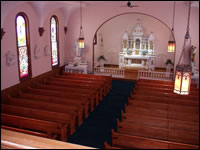
First of all, before the church was moved some renovation had to be done.
The original part of the church (rear section) was built in 1853. One section of that had to be torn off because of its deteriorating condition. After that was completed the exterior was then restored. The entire church had aluminum siding and that was all removed.
Two lean-to additions were added to the front in recent years, so they had to be removed and again the exterior restored.
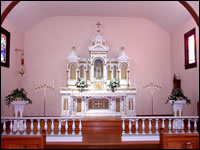
The lower left stained glass window was removed when the additions took place, therefore, it had to be re-installed and restored. The interior trim had to be literally hand made.
The last thing that had to be done before the move was the removal of the steeple. It was removed and taken to the park for later installation.
A concrete foundation was constructed and after the church was set in place native limestone was mortared in so that it's authentic looking.
Final touches were then put on the exterior. We found that the wood siding was different from what was available so it had to be beveled to match the original.
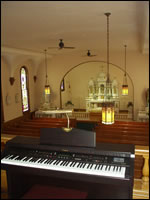
The steeple required some restoration and then it was re-set on the church.
At this point restoration commenced on the interior. The church had been modernized over the years and almost all the original furnishings had been removed such as the pews and alters.
There were some cracks in the walls that were repaired and then some research took place such as scraping through the paint etc. and an authentic color was selected to paint the walls. The woodwork had been grained for many years, so we stayed with that method and proceeded with the trim, wainscoting, etc.
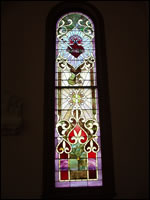
The oak flooring on the altar section was installed in the early 1900's when it was refinished. The floor in the main section was pinewood covered with tile. We found that it was impossible to remove, therefore, a new pine floor was installed in an authentic manner.
The altar railing had been removed, however, we had an old sample spindle and had them custom reproduced and completed the railing.
Some spindles were also missing from the balcony after the air conditioning units were removed and they too were restored.
The vestibule or entrance had embossed metal and again during modernization the metal from the wall was removed. We salvaged some metal from the rear section of the church that we had to tear off and it was used to restore the wall.
The front doors were special ordered to match the doors we found on an early photo of the church.
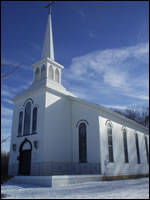
The stair railing was refinished and we found it was made of beautiful walnut.
The search went out for pews and altars. The alters were found in the old St. Joseph's Church in Preston, Iowa and the pews from old St. Joseph's Church in Kewanee, Illinois. They were then installed and painstakingly restored.
The original lower section of the main altar was found in a farmer's shed and had deteriorated. Some sections were used, however, it was cut down and refinished to show it's walnut splendor. It sets in the vestibule with the original altar stone.
Most of the work was performed by our personnel with the exception of the major projects such as the steeple.
Monetary donations were received by many persons to help finance the restoration and a bell was donated for the steeple. Other artifacts were donated as well.
It has enhanced our Pioneer Village and visitor counts have increased many times over. It also has been used for many weddings.

